
Concept explainers
(a)
Interpretation:
Whether the given compound is synthesized in good yield or not by an aldol condensation with its starting materials is to be stated. The reason as to why the required aldol condensation would not succeed for compound that is not synthesized in good yield is to be stated.
Concept Introduction:
Aldol condensation is the nucleophilic addition reaction of the carbonyl compounds. An enolate ion generated from one of the carbonyl compound attack the electrophilic carbon of the other carbonyl compound to produce β-hydroxy aldol or β-hydroxy
Answer to Problem 22.22P
The given compound can be synthesized using aldol condensation in good yield. The starting materials are p−methoxybenzaldehyde and pentan−3−one.
Explanation of Solution
The given compound is shown below.
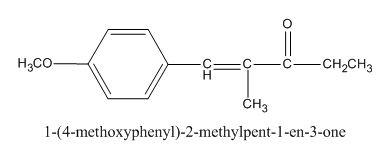
Figure 1
In the above preparation of the compound, the enolate is generated on the α− carbon of the pentan−3−one which is favorable to be generated on ketone rather than
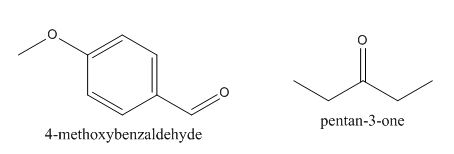
Figure 2
The given compound can be synthesized by aldol condensation of p−methoxybenzaldehyde and pentan−3−one.
(b)
Interpretation:
Whether the given compound is synthesized in good yield or not by an aldol condensation with its starting materials is to be stated. The reason as to why the required aldol condensation would not succeed for compound that is not synthesized in good yield is to be stated.
Concept Introduction:
Aldol condensation is the nucleophilic addition reaction of the carbonyl compounds. An enolate ion generated from one of the carbonyl compound attack the electrophilic carbon of the other carbonyl compound to produce β-hydroxy aldol or β-hydroxy ketone. This product further gives dehydration or condensation product by elimination small molecule such as water.
Answer to Problem 22.22P
The given compound can be synthesized using aldol condensation in good yield. The starting materials are benzaldehyde and hexan−3−one.
Explanation of Solution
The given compound is shown below.
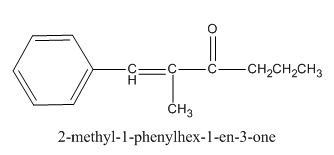
Figure 3
In the preparation of the above compound, the enolate will be generated on the α− carbon of hexan−3−one which is favorable to be generated on ketone rather than aldehyde. The enolate will then attack the electrophilic carbon of the benzaldehyde to produce the β−hydroxyketone which is finally dehydrated to give the condensed product.
The structures of the starting materials which are used to produce the given compound are shown below.
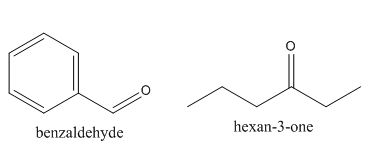
Figure 4
The given compound can be synthesized by aldol condensation of benzaldehyde and hexan−3−one.
(c)
Interpretation:
Whether the given compound is synthesized in good yield or not by an aldol condensation with its starting materials is to be stated. The reason as to why the required aldol condensation would not succeed for compound that is not synthesized in good yield is to be stated.
Concept Introduction:
Aldol condensation is the nucleophilic addition reaction of the carbonyl compounds. An enolate ion generated from one of the carbonyl compound attack the electrophilic carbon of the other carbonyl compound to produce β-hydroxy aldol or β-hydroxy ketone. This product further gives dehydration or condensation product by elimination small molecule such as water.
Answer to Problem 22.22P
The given compound can be synthesized using aldol condensation but not in a good in good yield. The starting material is 7−oxoctanal.
Explanation of Solution
The given compound is shown below.
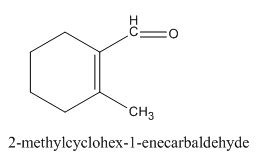
Figure 5
In the preparation of the above compound, intramolecular aldol condensation takes place. To form this compound enolate must be generated by aldehyde and it has to attack the carbonyl carbon of ketone which is not favorable condition. Favorable condition is that enolate should be generated on ketone which attacks the electrophilic carbon of the aldehyde. This is because the carbon of aldehyde is more acidic than the carbon of ketone. The structure of the starting material which is used to produce the given compound is shown below.
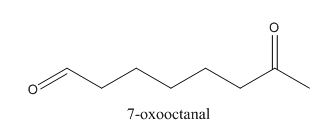
Figure 6
Therefore, the given compound cannot be synthesized by aldol condensation in a good yield.
This compound cannot be synthesized in a good yield by the aldol condensation.
(d)
Interpretation:
Whether the given compound is synthesized in good yield or not by an aldol condensation with its starting materials is to be stated. The reason as to why the required aldol condensation would not succeed for compound that is not synthesized in good yield is to be stated.
Concept Introduction:
Aldol condensation is the nucleophilic addition reaction of the carbonyl compounds. An enolate ion generated from one of the carbonyl compound attack the electrophilic carbon of the other carbonyl compound to produce β-hydroxy aldol or β-hydroxy ketone. This product further gives dehydration or condensation product by elimination small molecule such as water.
Answer to Problem 22.22P
The given compound can be synthesized by aldol condensation in good yield. The starting material is 6−oxoheptanal.
Explanation of Solution
The given compound is shown below.
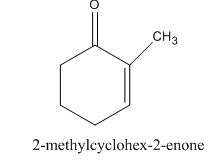
Figure 7
The given compound, is prepared by the intramolecular aldol condensation of 6−oxoheptanal to produce the β−hydroxyketone which is finally dehydrated to give the condensed product. This compound is prepared in a good yield because of the presence of the three acidic carbon atoms which results in the formation of carbanion at three different places. The structure of the starting material which is used to produce the given compound is shown below.
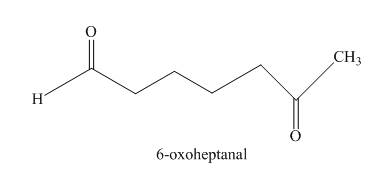
Figure 8
The given compound can be synthesized by intramolecular aldol condensation of 6−oxoheptanal in a good yield.
(e)
Interpretation:
Whether the given compound is synthesized in good yield or not by an aldol condensation with its starting materials is to be stated. The reason as to why the required aldol condensation would not succeed for compound that is not synthesized in good yield is to be stated.
Concept Introduction:
Aldol condensation is the nucleophilic addition reaction of the carbonyl compounds. An enolate ion generated from one of the carbonyl compound attack the electrophilic carbon of the other carbonyl compound to produce β-hydroxy aldol or β-hydroxy ketone. This product further gives dehydration or condensation product by elimination small molecule such as water.
Answer to Problem 22.22P
The given compound can be synthesized from aldol condensation in a good yield. The starting materials are: 1,3−diphenylpropan−2−one and benzil.
Explanation of Solution
The given compound is shown below.
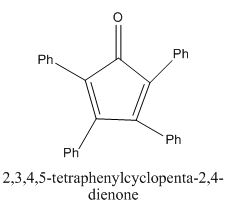
Figure 9
In the preparation of the given compound, the enolate will be generated on the α-carbon of the ketone group of 1,3−diphenylpropan−2−one which is the only possibility of generation of enolate in the 1,3−diphenylpropan−2−one. The enolate will then attack the electrophilic carbon of the ketone group of the benzil to produce β−hydroxyketone which is finally dehydrated to give the condensed product. The structures of the starting materials are shown below.
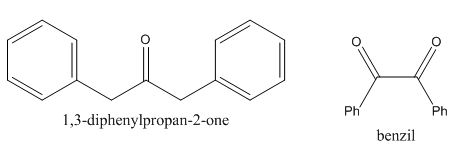
Figure 10
The given compound can be synthesized by aldol condensation of 1,3−diphenylpropan−2−one and benzyl in a good yield.
(f)
Interpretation:
Whether the given compound is synthesized in good yield or not by an aldol condensation with its starting materials is to be stated. The reason as to why the required aldol condensation would not succeed for compound that is not synthesized in good yield is to be stated.
Concept Introduction:
Aldol condensation is the nucleophilic addition reaction of the carbonyl compounds. An enolate ion generated from one of the carbonyl compound attack the electrophilic carbon of the other carbonyl compound to produce β-hydroxy aldol or β-hydroxy ketone. This product further gives dehydration or condensation product by elimination small molecule such as water.
Answer to Problem 22.22P
The given compound can be synthesized by aldol condensation in a good yield. The starting materials are 2 moles of benzaldehyde and acetone.
Explanation of Solution
The given compound is shown below.
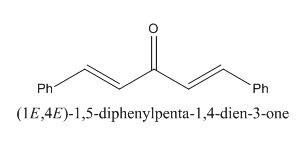
Figure 11
In the preparation of the compound, the enolate is generated on the α-carbon of the ketonic group of acetone which is favorable to be generated on ketone rather than aldehyde. The enolate will then attack the electrophilic carbon of the aldehyde group of the benzaldehyde to produce β−hydroxyketone is finally dehydrated to give the condensed product. The structures of the starting materials for the preparation of the given compound are shown below.
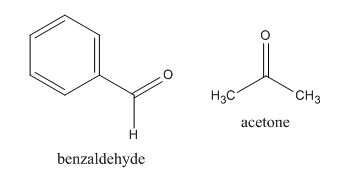
Figure 12
The given compound can be synthesized by aldol condensation of benzaldehyde and acetone.
(g)
Interpretation:
Whether the given compound is synthesized in good yield or not by an aldol condensation with its starting materials is to be stated. The reason as to why the required aldol condensation would not succeed for compound that is not synthesized in good yield is to be stated.
Concept Introduction:
Aldol condensation is the nucleophilic addition reaction of the carbonyl compounds. An enolate ion generated from one of the carbonyl compound attack the electrophilic carbon of the other carbonyl compound to produce β-hydroxy aldol or β-hydroxy ketone. This product further gives dehydration or condensation product by elimination small molecule such as water.
Answer to Problem 22.22P
The given compound can be synthesized by aldol condensation. The starting materials are trimethylacetone and acetaldehyde.
Explanation of Solution
The given compound is shown below.
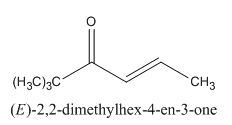
Figure 13
In the preparation of the given compound, the enolate will be generated on the α-carbon of the ketonic group of trimethylacetone which is favorable to be generated on ketone rather than aldehyde. The enolate will then attack the electrophilic carbon of the aldehyde group of the acetaldehyde to produce β−hydroxyketone which is finally dehydrated to give the condensed product. The structures of the starting materials, acetaldehyde and trimethylacetone are shown below.
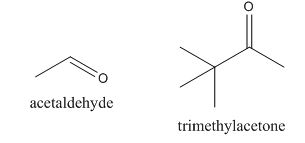
Figure 14
The given compound can be synthesized by aldol condensation by trimethylacetone and acetaldehyde in a good yield.
(h)
Interpretation:
Whether the given compound is synthesized in good yield or not by an aldol condensation with its starting materials is to be stated. The reason as to why the required aldol condensation would not succeed for compound that is not synthesized in good yield is to be stated.
Concept Introduction:
Aldol condensation is the nucleophilic addition reaction of the carbonyl compounds. An enolate ion generated from one of the carbonyl compound attack the electrophilic carbon of the other carbonyl compound to produce β-hydroxy aldol or β-hydroxy ketone. This product further gives dehydration or condensation product by elimination small molecule such as water.
Answer to Problem 22.22P
The given compound can be synthesized by aldol condensation in a good yield. The starting material is cyclodecan−1,6−dione.
Explanation of Solution
The given compound is shown below.
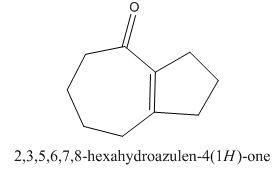
Figure 15
The enolate will be generated on the α-carbon of the ketonic group of cyclodecan−1,6−dione which is favorable to be generated on ketone rather than aldehyde. The enolate will then attack the electrophilic carbon of the aldehyde group of the cyclodecan−1,6−dione to produce β−hydroxyketone which is finally dehydrated to give the condensed product. The structure of the starting material is shown below.
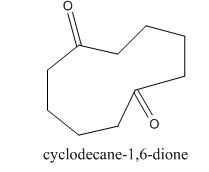
Figure 16
The given compound can be synthesized by aldol condensation of cyclodecan−1,6−dione in a good yield.
Want to see more full solutions like this?
Chapter 22 Solutions
Organic Chemistry
- -AG|F=2E|V 3. Before proceeding with this problem you may want to glance at p. 466 of your textbook where various oxo-phosphorus derivatives and their oxidation states are summarized. Shown below are Latimer diagrams for phosphorus at pH values at 0 and 14: Acidic solution -0.93 +0.38 -0.51 -0.06 H3PO4 →H4P206 H3PO3 H3PO2 → P→ PH3 -0.28 -0.50 → -0.50 Basic solution 3-1.12 -1.57 -2.05 -0.89 PO HPO →→H2PO2 P PH3 -1.73 a) Under acidic conditions, H3PO4 can be reduced into H3PO3 directly (-0.28V), or via the formation and reduction of H4P2O6 (-0.93/+0.38V). Calculate the values of AG's for both processes; comment. (3 points) 0.5 PH, 0.0 -0.5- 2 3 9 3 -1.5 -2.0 Pa H,PO H,PO H,PO -3 -1 0 2 4 Oxidation state, N 2 b) Frost diagram for phosphorus under acidic conditions is shown. Identify possible disproportionation and comproportionation processes; write out chemical equations describing them. (2 points) c) Elemental phosphorus tends to disproportionate under basic conditions. Use data in…arrow_forwardThese two reactions appear to start with the same starting materials but result in different products. How do the chemicals know which product to form? Are both products formed, or is there some information missing that will direct them a particular way?arrow_forwardWhat would be the best choices for the missing reagents 1 and 3 in this synthesis? 1. PPh3 3 1 2 2. n-BuLi • Draw the missing reagents in the drawing area below. You can draw them in any arrangement you like. • Do not draw the missing reagent 2. If you draw 1 correctly, we'll know what it is. • Note: if one of your reagents needs to contain a halogen, use bromine. Explanation Check Click and drag to start drawing a structure. 2025 McGraw Hill LLC. All Rights Reserved. Terms of Use | Priva ×arrow_forward
- Predict the products of this organic reaction: Explanation Check IN NaBH3CN H+ ? Click and drag to start drawing a structure. D 5 C +arrow_forwardPredict the products of this organic reaction: H3O+ + ? • Draw all the reasonable products in the drawing area below. If there are no products, because no reaction will occur, check the box under the drawing area. • Include both major and minor products, if some of the products will be more common than others. • Be sure to use wedge and dash bonds if you need to distinguish between enantiomers. No reaction. Click and drag to start drawing a structure. dmarrow_forwardIarrow_forward
- Draw the anti-Markovnikov product of the hydration of this alkene. this problem. Note for advanced students: draw only one product, and don't worry about showing any stereochemistry. Drawing dash and wedge bonds has been disabled for esc esc ☐ Explanation Check F1 1 2 F2 # 3 F3 + $ 14 × 1. BH THE BH3 2. H O NaOH '2 2' Click and drag to start drawing a structure. F4 Q W E R A S D % 905 LL F5 F6 F7 © 2025 McGraw Hill LLC. All Rights Reserved. Terms of Use | Privacy Center | Accessibility < & 6 7 27 8 T Y U G H I F8 F9 F10 F11 F12 9 0 J K L P + // command option Z X C V B N M H H rol option commandarrow_forwardAG/F-2° V 3. Before proceeding with this problem you may want to glance at p. 466 of your textbook where various oxo-phosphorus derivatives and their oxidation states are summarized. Shown below are Latimer diagrams for phosphorus at pH values at 0 and 14: -0.93 +0.38 -0.50 -0.51 -0.06 H3PO4 →H4P206 →H3PO3 →→H3PO₂ → P → PH3 Acidic solution Basic solution -0.28 -0.50 3--1.12 -1.57 -2.05 -0.89 PO HPO H₂PO₂ →P → PH3 -1.73 a) Under acidic conditions, H3PO4 can be reduced into H3PO3 directly (-0.28V), or via the formation and reduction of H4P206 (-0.93/+0.38V). Calculate the values of AG's for both processes; comment. (3 points) 0.5 PH P 0.0 -0.5 -1.0- -1.5- -2.0 H.PO, -2.3+ -3 -2 -1 1 2 3 2 H,PO, b) Frost diagram for phosphorus under acidic conditions is shown. Identify possible disproportionation and comproportionation processes; write out chemical equations describing them. (2 points) H,PO 4 S Oxidation stale, Narrow_forward4. For the following complexes, draw the structures and give a d-electron count of the metal: a) Tris(acetylacetonato)iron(III) b) Hexabromoplatinate(2-) c) Potassium diamminetetrabromocobaltate(III) (6 points)arrow_forward
- 2. Calculate the overall formation constant for [Fe(CN)6]³, given that the overall formation constant for [Fe(CN)6] 4 is ~1032, and that: Fe3+ (aq) + e = Fe²+ (aq) E° = +0.77 V [Fe(CN)6]³ (aq) + e¯ = [Fe(CN)6] (aq) E° = +0.36 V (4 points)arrow_forward5. Consider the compounds shown below as ligands in coordination chemistry and identify their denticity; comment on their ability to form chelate complexes. (6 points) N N A B N N N IN N Carrow_forward1. Use standard reduction potentials to rationalize quantitatively why: (6 points) (a) Al liberates H2 from dilute HCl, but Ag does not; (b) Cl2 liberates Br2 from aqueous KBr solution, but does not liberate C12 from aqueous KCl solution; c) a method of growing Ag crystals is to immerse a zinc foil in an aqueous solution of AgNO3.arrow_forward
 Organic ChemistryChemistryISBN:9781305580350Author:William H. Brown, Brent L. Iverson, Eric Anslyn, Christopher S. FootePublisher:Cengage Learning
Organic ChemistryChemistryISBN:9781305580350Author:William H. Brown, Brent L. Iverson, Eric Anslyn, Christopher S. FootePublisher:Cengage Learning
